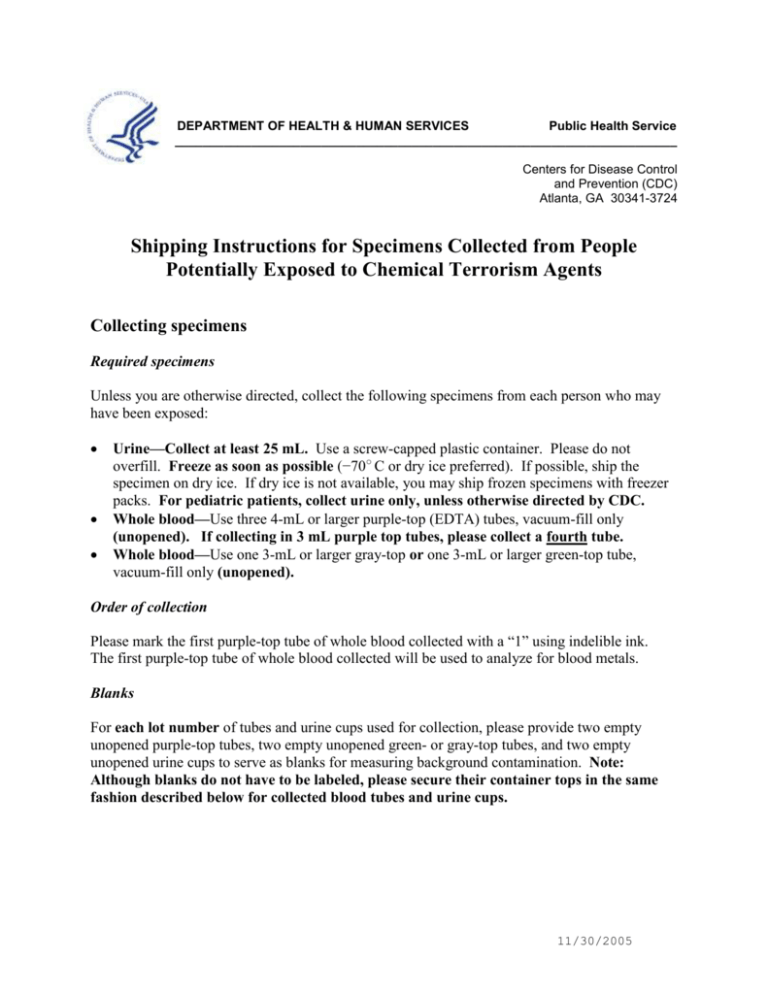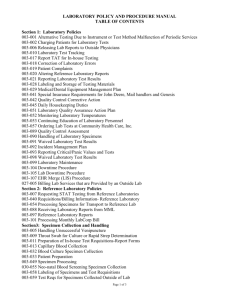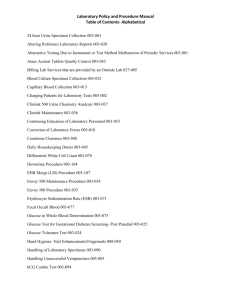Shipping instructions, Page 1 of 5 DEPARTMENT OF HEALTH
advertisement

DEPARTMENT OF HEALTH & HUMAN SERVICES Public Health Service ________________________________________________________________________ Centers for Disease Control and Prevention (CDC) Atlanta, GA 30341-3724 Shipping Instructions for Specimens Collected from People Potentially Exposed to Chemical Terrorism Agents Collecting specimens Required specimens Unless you are otherwise directed, collect the following specimens from each person who may have been exposed: Urine—Collect at least 25 mL. Use a screw-capped plastic container. Please do not overfill. Freeze as soon as possible (−70○ C or dry ice preferred). If possible, ship the specimen on dry ice. If dry ice is not available, you may ship frozen specimens with freezer packs. For pediatric patients, collect urine only, unless otherwise directed by CDC. Whole blood—Use three 4-mL or larger purple-top (EDTA) tubes, vacuum-fill only (unopened). If collecting in 3 mL purple top tubes, please collect a fourth tube. Whole blood—Use one 3-mL or larger gray-top or one 3-mL or larger green-top tube, vacuum-fill only (unopened). Order of collection Please mark the first purple-top tube of whole blood collected with a “1” using indelible ink. The first purple-top tube of whole blood collected will be used to analyze for blood metals. Blanks For each lot number of tubes and urine cups used for collection, please provide two empty unopened purple-top tubes, two empty unopened green- or gray-top tubes, and two empty unopened urine cups to serve as blanks for measuring background contamination. Note: Although blanks do not have to be labeled, please secure their container tops in the same fashion described below for collected blood tubes and urine cups. 11/30/2005 Shipping instructions, Page 2 of 5 Labeling Label specimens with labels generated by your facility. These labels may include the following information: medical records number, specimen identification number, collector’s initials, and date and time of collection. Follow your facility’s procedures for proper specimen labeling. The collector’s initials and date and time of collection will allow law enforcement officials to trace the specimen back to the collector should the case go to court and the collector is needed to testify that they collected the specimen. Information provided on labels may prove helpful in correlating the results obtained from the Rapid Toxic Screen and subsequent analysis with the people from whom the specimens were collected. Place a single, unbroken strip of waterproof, tamper-evident forensic evidence tape over each specimen top, being careful not to cover the specimen ID labels. This tape must make contact with the specimen container at two points. The individual placing the evidence tape must identify themselves by writing their initials ½ on the container and ½ on the evidence tape. Maintain a list of names with corresponding specimen identification numbers at the collection site to enable results to be reported to the patients. Packaging Packaging consists of three components: primary receptacle (blood tubes or urine cups), secondary packaging (materials for protecting primary receptacles, absorbent material, and waterproof, 95 kPa pressure resistant packaging), and an outer packaging (Styrofoam-insulated corrugated, fiberboard box). Pack and ship these specimens as category B infectious substances. Secondary packaging Blood Tubes— Separate each tube of blood collected from other tubes, or wrap tubes to prevent contact between tubes; this may be accomplished in a variety of ways such as a gridded box wrapped with absorbent material and sealed inside a plastic bag, sealable Styrofoam container, blood tube shipment sleeve and transport tube, and individually wrapped tubes sealed inside a plastic bag. Secondary packaging must have its closure secured with a single strip of tamper-evident forensic evidence tape initialed ½ on the packaging and ½ on the evidence tape by the individual making the seal. Place absorbent material between the primary receptacle and the secondary packaging. Use enough absorbent material to absorb the entire contents of primary receptacles. According to 49 CFR 173.199(b), if specimens are to be transported by air, either the primary receptacle or the secondary packaging used must be capable of withstanding without leakage an internal pressure producing a pressure differential of not less than 95 kPa 11/30/2005 Shipping instructions, Page 3 of 5 (0.95 bar, 14 psi). Verify in advance that the manufacturer of either the blood tube or secondary packaging used in your facility is in compliance with the pressure differential requirement. To facilitate processing, package blood tubes so that similar tubes are packaged together (e.g., all purple-tops together) and not mixed (i.e., purple-tops and green/gray-tops in the same package). Urine Cups— Separate each urine cup from other urine cups or wrap urine cups to prevent contact between urine cups. Place urine cups in secondary packages. A variety of secondary packages may be used, for example, gridded box wrapped with absorbent material and sealed inside a plastic bag or individually wrapped urine cups sealed inside a plastic bag. In either case verify that the urine cup or secondary packaging complies with the requirements stated in 49 CFR173.199(b). Secondary packaging must have its closure secured with a single strip of tamper-evident forensic evidence tape initialed ½ on the packaging and ½ on the evidence tape by the individual making the seal. Outer packaging Use Styrofoam-insulated corrugated fiberboard boxes (may be available from your transfusion service or send-outs department). Do not ship frozen urine cups and blood tubes in the same package. Blood tubes— Ship at 4C For cushioning, place additional absorbent material in the bottom of the outer packaging. Add a layer of frozen cold packs. Place secondary packagings on top of the cold packs. Place additional cold packs or absorbent material between the secondary packagings to reduce their movement within the outer packaging. Place a layer of frozen cold packs on top of the secondary packagings. Urine cups— Ship to ensure specimens remain frozen or freeze while in transport For cushioning, place additional absorbent material in the bottom of the outer packaging. Add a layer of dry ice. Note: Do not use large chunks of dry ice for shipment, because large chunks have the potential for shattering urine cups during transport. Place additional absorbent material between wrapped urine cups to reduce their movement within the outer packaging. Add an additional layer of dry ice. 11/30/2005 Shipping instructions, Page 4 of 5 Preparing documentation Since blood tubes and urine cups are shipped separately, prepare a separate shipping manifest for each. Place each shipping manifest (with specimen identification numbers) in a plastic zippered bag on top of the specimens before closing the Styrofoam lid of the corrugated fiberboard box. Chain of custody forms do not need to be transported with specimens. Each entity/organization handling the specimens is responsible for the specimens only during the time that they have control of the specimens. Each entity/organization receiving the specimens must sign-off on the chain of custody form of the entity/organization relinquishing the specimens to close that chain. When receiving specimens, each new entity/organization must begin their own chain of custody and have the entity/organization relinquishing the specimens sign their chain of custody to start the chain and indicate that they have transferred the specimens. When specimens are transferred between entities/organizations, each entity/organization retains their chain of custody forms. Note: When the individual relinquishing the specimens (relinquisher) and the individual receiving the specimens (receiver) are not together at the time of specimen transfer, the relinquisher will document on their chain of custody that the receiver is FedEx Tracking Number or have the individual transporting the specimens sign the chain of custody to indicate that they have taken control of the specimens. Likewise, when the receiver receives the specimens, they will document on their chain of custody that the relinquisher is FedEx Tracking Number or the have the individual transporting the specimens sign the chain of custody. Preparing packaged specimens for shipment Secure outer packaging tops and bottoms with filamentous shipping/strapping tape. Affix labels and markings adjacent to the shipper’s/consignee’s address that appears on the package. Place a UN 3373 diamond marking on the outer package. Place the proper shipping name, “Biological substance category B” on the outer packaging adjacent to the UN3373 marking. For packages containing dry ice, place a class 9 hazard label on the same side of the outer packaging as the UN3373 marking. If the proper shipping name, either dry ice or carbon dioxide solid, and UN1845 is not preprinted on the hazard label, add it adjacent to the label. Note the weight of dry ice in the packaging on the preprinted area of the hazard label or place that information adjacent to the class 9 hazard label and proper shipping name. Orientation arrows are not required on an outer packaging containing category B infectious substances. If orientation arrows are present, be sure to orient the inner packagings with their closures in the proper orientation with the arrows. If the package will be transported by a commercial air carrier, complete an airway bill. On the airway bill, note the proper shipping name and UN number for each hazardous material and identify a person responsible for the package per IATA packing instruction 650. 11/30/2005 Shipping instructions, Page 5 of 5 Shipping specimens Follow the guidance provided in your state’s chemical terrorism comprehensive response plan. If you are directed to ship the specimens to CDC, please ship the specimens to the following address: CDC Attn: Charles Dodson 4770 Buford Hwy, Building 103 Loading Dock Atlanta, GA 30341 (770) 488-4305 Questions If you have any questions or problems with specimen packaging or shipment, please e-mail or call one of the following contacts at the CDC’s National Center for Environmental Health, Division of Laboratory Sciences (DLS): Jacob Wamsley, DLS Incident Response Laboratory Coordinator jwamsley@cdc.gov (770) 294-2491 or Julia Ellenberg jellenberg@cdc.gov (770) 488-4135. Dr. John Osterloh, DLS Chief Medical Officer, 770-488-7367 DLS administrative office, 770-488-7950 11/30/2005






